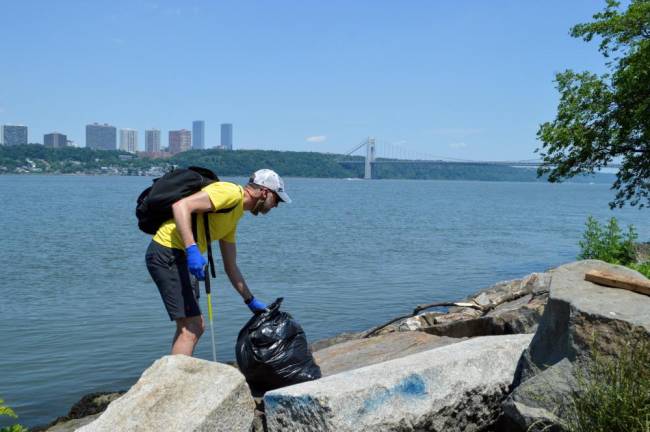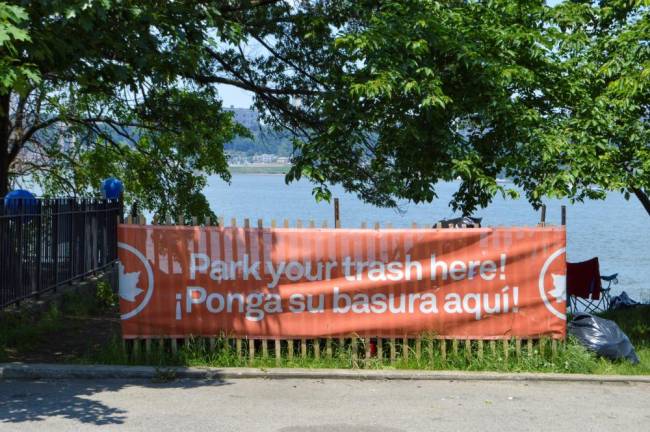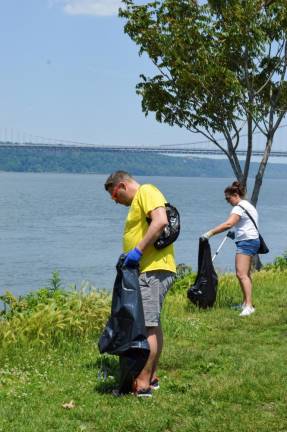Volunteers Tackle Litter to Keep Riverside Park Pristine
Trash Hero New York cleans up during the pandemic amid increased park usage — and more trash



In 90-degree heat on the first Sunday in June, a small, determined group of volunteers gathered at Riverside Park’s Ten Mile River Playground to clean up debris along the water’s edge. Armed with black trash bags, trash-grabbing tools and yellow T-shirts bearing the slogan “I’m A Trash Hero,” they turned their gaze not only to stray bottle caps and miniature liquor bottles — the remnants of past festivities — but also to park-goers currently enjoying the outdoors.
“If people can see that we’re helping, taking care of this resource,” said Drew Marlar, the chapter leader of Trash Hero New York, “they’ll think about their own consumption — what are they doing with their garbage?”
Trash Hero New York was founded in 2016 as the first U.S.-based branch of Trash Hero World, which grew from its inception in Thailand in 2013 to facilitate trash collection in 19 countries with over 170 chapters.
By cleaning up parts of the Upper West Side and beyond, including Riverside Park, Trash Hero New York volunteers hope to also sow the seeds for longer-lasting efforts to keep the city pristine. During the pandemic, parks have seen an increase in use, with outdoor locations offering a refuge amid social (and physical) isolation. But COVID-19 also took a toll on the New York City Department of Parks and Recreation, with budget cuts forcing smaller maintenance crews than before. Now, even as life in the city returns to normal, extra efforts are still underway to keep littering at bay.
“To give back to New York — and to make sure that it remains a great destination and it looks great — is important to me,” said Upper East Sider Fleur Sohtz, who volunteers with Trash Hero New York.
“Stay Sane”
Under Marlar’s guidance, Trash Hero New York volunteers meet nearly every week to collect stray trash from locations in the Upper West Side and Harlem. Sometimes, the group is composed of only a handful of volunteers; other times, numbers top 20. When Trash Hero New York volunteers convene in Riverside Park every other month, they’re aided by the Riverside Park Conservancy, which supplies cleanup tools (like trash bags) and oversight in determining which areas of the park need attention.
To supplement its own maintenance efforts, which include trash collection and landscaping within the roughly 400 acres of Riverside Park by approximately 250 “park tenders,” according to Riverside Park Conservancy President and CEO Dan Garodnick, the conservancy also collaborates with groups like local environmental organization Riverkeeper, the American Littoral Society, and OneBlock, another Upper West Side neighborhood cleanup group. During the first summer of the pandemic, and again this summer, the conservancy hired an additional group, Goddard Riverside, to address a greater-than-usual need for trash collection.
One reason for “garbage literally piling up” at Riverside Park, Garodnick explained, might be the “unprecedented” use of parks during the pandemic.
“Every day, people were relying on their parks to safely socialize, to exercise, to protest,” he said, “and to stay sane.”
Overflowing Trash Cans
Last year, however, the New York City Department of Parks and Recreation saw a budget cut of $84 million, according to several published reports, during the pandemic. The decreased budget, a Parks Department press officer wrote in an email, impacted the number of city employees caring for parks; seasonal maintenance and operations staff numbers dwindled from 2,600 workers to only 1,000.
Anecdotally, Marlar noticed overflowing trash cans — and a decline in the number of trash cans — in parks and on city streets.
“It was really alarming when I first got here,” Marlar said of his move to the city in October. “And I was shocked at how much garbage was on the sidewalks.”
Last summer, the city launched a new campaign with advertisements and “trash corrals” to discourage littering, according to a Parks Department press release from Aug. 2020. This spring, the Parks Department has renewed its campaign to curb littering in city parks with over 150 trash corrals. A press officer estimated that this year, the Parks Department will once again hire 2,600 seasonal maintenance and operations staff along with 2,500 City Cleanup Corps staff.
Fielding Questions
Trash Hero New York volunteers worked in close proximity to one such Parks Department trash collection site during their cleanup at the start of the month, removing litter primarily from the shoreline as they walked North along the Hudson River. In total, they collected over 15 trash bags of debris while also fielding questions from park-goers inquiring about the level of trash in the park and what they could do to pitch in.
When approached by onlookers about his work for Trash Hero New York, Marlar typically presents a QR code on his phone that links to the group’s Facebook page, where he posts about the outcomes of cleanup events with the hope of attracting future volunteers.
For some volunteers, like Sohtz and Ross Paterson, both of whom swim with Marlar on the AGUA Masters swim team, cleaning up trash along the water at Riverside Park this month felt especially important. “We actually sometimes swim in there,” Paterson said of the Hudson River, referencing a swim around the island of Manhattan known as 20 Bridges, which he plans to attempt next month. “So we don’t want it to be too polluted.”
While praise from fellow park enthusiasts isn’t the primary aim of Trash Hero New York’s endeavors, Marlar explained, it often comes as an added perk — “it just starts this community effort.”